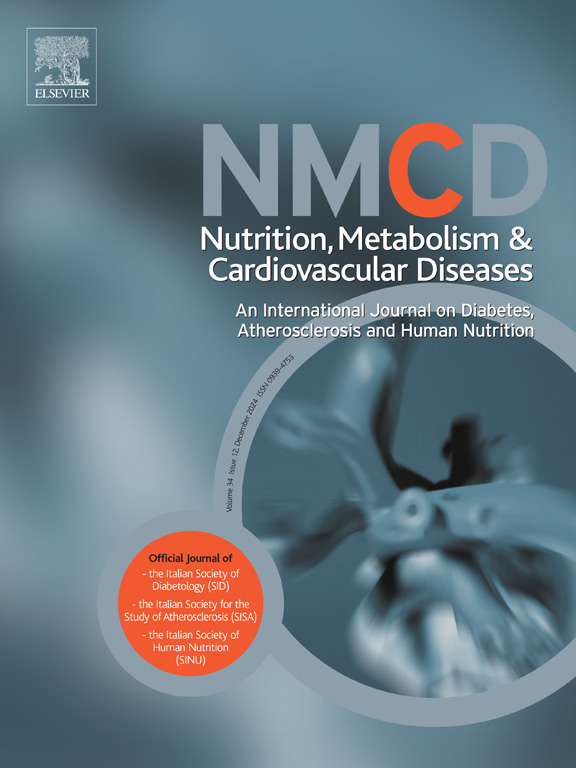Impact of cardiometabolic risk factors for metabolic dysfunction-associated steatotic liver disease on mortality
IF 3.3
3区 医学
Q2 CARDIAC & CARDIOVASCULAR SYSTEMS
Nutrition Metabolism and Cardiovascular Diseases
Pub Date : 2025-02-26
DOI:10.1016/j.numecd.2025.103965
引用次数: 0
Abstract
Background and aims
Metabolic dysfunction–associated steatotic liver disease (MASLD) is a potential independent risk factor for cardiovascular disease (CVD)-associated and all-cause mortalities as they share common risk factors. We investigated the association between cardiometabolic risk factors for MASLD and CVD-associated and all-cause mortality risks in middle-aged and older Korean adults.
Methods and results
We used data from the Korean Genome and Epidemiology Study, a population-based prospective cohort study. Five cardiometabolic risk factors were assessed. MASLD was defined as liver steatosis with a fatty liver index (FLI) ≥60 and at least one cardiometabolic risk factor. The non-MASLD group included individuals with a FLI <60 or FLI ≥60 without cardiometabolic risk factors. The primary outcomes were CVD-associated and all-cause mortalities. Cox proportional hazard models were used to evaluate the association between cardiometabolic risk factors for MASLD and mortalities, adjusting for covariates. Multivariable Cox regression analysis revealed that the MASLD group had increased CVD-associated and all-cause mortality risks compared to the non-MASLD group. The presence of three or more and one or more cardiometabolic risk factors significantly increased the CVD-associated and all-cause mortality rate, respectively. The combination of hypertriglyceridemia, low high-density lipoprotein cholesterol (HDL-C), and high glucose concentrations significantly increased both CVD-associated (hazard ratio [HR] 3.64; 95 % confidence interval [CI] 1.44–9.22; p = 0.006) and all-cause (HR 4.57; 95 % CI: 1.74–12.05; p = 0.002) mortality risks.
Conclusion
Cardiometabolic risk factors for MASLD are strongly associated with higher CVD-associated and all-cause mortality risks, highlighting the need to manage hypertriglyceridemia, low HDL-C, and high glucose concentrations.

代谢功能障碍相关脂肪变性肝病的心脏代谢危险因素对死亡率的影响
背景和目的:代谢功能障碍相关脂肪变性肝病(MASLD)是心血管疾病(CVD)相关和全因死亡的潜在独立危险因素,因为它们具有共同的危险因素。我们调查了韩国中老年成人MASLD和cvd相关的心脏代谢危险因素和全因死亡风险之间的关系。方法和结果:我们使用的数据来自韩国基因组和流行病学研究,这是一项基于人群的前瞻性队列研究。评估了五种心脏代谢危险因素。MASLD定义为脂肪肝指数(FLI)≥60且至少有一种心脏代谢危险因素的肝脏脂肪变性。结论:MASLD的心脏代谢危险因素与cvd相关和全因死亡风险较高密切相关,强调需要控制高甘油三酯血症、低HDL-C和高血糖浓度。
本文章由计算机程序翻译,如有差异,请以英文原文为准。
求助全文
约1分钟内获得全文
求助全文
来源期刊
CiteScore
6.80
自引率
2.60%
发文量
332
审稿时长
57 days
期刊介绍:
Nutrition, Metabolism & Cardiovascular Diseases is a forum designed to focus on the powerful interplay between nutritional and metabolic alterations, and cardiovascular disorders. It aims to be a highly qualified tool to help refine strategies against the nutrition-related epidemics of metabolic and cardiovascular diseases. By presenting original clinical and experimental findings, it introduces readers and authors into a rapidly developing area of clinical and preventive medicine, including also vascular biology. Of particular concern are the origins, the mechanisms and the means to prevent and control diabetes, atherosclerosis, hypertension, and other nutrition-related diseases.

 求助内容:
求助内容: 应助结果提醒方式:
应助结果提醒方式:


